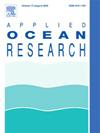双浮式风力发电机共享系泊缆结构设计与全局分析
IF 4.3
2区 工程技术
Q1 ENGINEERING, OCEAN
引用次数: 0
摘要
浮式海上风力涡轮机(fowt)的共享系泊配置为显著降低风电场的总体成本提供了一个有前途的解决方案。本研究提出了一个详细的框架来分析利用共享系泊线配置的fowt。选择了一个案例研究,涉及两个5mw的CSC fowt,通过一条共享系泊线连接。首先,利用偏移圈表征共享系泊线系统(SM)在各方向稳定风荷载作用下的平台偏移量。接下来,在考虑环境载荷的全方向性的情况下,评估了SM在50年回归周期的不规则波浪和湍流条件下的动态响应,包括平台运动、风力涡轮机塔弯矩和系泊线张力。结果与单个系泊系统(IM)的结果进行了基准测试。分析证实了SM配置的可行性,与IM相比,最大系泊线利用率仅增加了5%。然而,SM显示出更大的水平偏移量,其中最大偏移量是IM中观察到的两倍多。当风力涡轮机运行时,SM中较高的平均浪涌偏移量导致平均张力水平增加,使锚索张力对波频激励更加敏感。尽管存在这些挑战,但SM配置显示出强大的经济潜力,与IM相比,估计可以降低20%的系泊成本。本文章由计算机程序翻译,如有差异,请以英文原文为准。
Design and global analysis of two floating wind turbines in a shared mooring line configuration
Shared mooring configurations for floating offshore wind turbines (FOWTs) offer a promising solution to significantly reduce the overall costs of wind farms. This study presents a detailed framework for analyzing FOWTs utilizing a shared mooring line configuration. A case study involving two 5-MW CSC FOWTs connected by a single shared mooring line is selected. First, excursion circles are used to characterize platform offsets for the shared mooring line system (SM) under steady wind loads from all directions. Next, dynamic responses—including platform motions, wind turbine tower bending moments, and mooring line tensions—are evaluated for the SM under irregular wave and turbulent wind conditions corresponding to a 50-year return period, while accounting for the full directionality of environmental loads. The results are benchmarked against those of an individual mooring system (IM). The analysis confirms the viability of the SM configuration, with only a 5 % increase in the maximum mooring line utilization factor compared to the IM. However, the SM exhibits significantly larger horizontal offsets, with the maximum offsets of the FOWTs more than double those observed in the IM. When the wind turbines are operational, the higher mean surge offsets in the SM lead to increased mean tension levels, making the anchor line tensions more sensitive to wave-frequency excitations. Despite these challenges, the SM configuration demonstrates strong economic potential, achieving an estimated 20 % reduction in mooring costs compared to the IM.
求助全文
通过发布文献求助,成功后即可免费获取论文全文。
去求助
来源期刊

Applied Ocean Research
地学-工程:大洋
CiteScore
8.70
自引率
7.00%
发文量
316
审稿时长
59 days
期刊介绍:
The aim of Applied Ocean Research is to encourage the submission of papers that advance the state of knowledge in a range of topics relevant to ocean engineering.
 求助内容:
求助内容: 应助结果提醒方式:
应助结果提醒方式:


